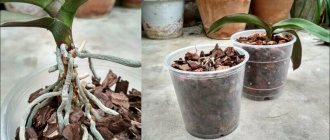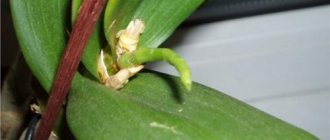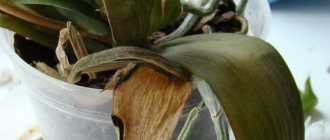Life cycle of a healthy plant
Observations show that the average flowering of an orchid lasts for about three months. This usually happens 2-3 times a year, with breaks for special dormant times, when the plant can rest and gain strength before flowering again.
If a healthy-looking orchid does not bloom, you should pay attention to the conditions of detention , because this is the main indicator of what is happening to your flower.
When is there cause for concern?
Usually blooming specimens are purchased at a flower shop.
In this case, they will drop their flowers in a couple of weeks or months. When will they bloom again and why is it taking so long? If adult orchids at home do not gain color after 1-1.5 years, then there is definitely cause for concern.
This time is enough for the adaptation period to end, and if the flower does not release an arrow, then something is going wrong in the life of the plant.
Ways to rejuvenate an old plant
How to rejuvenate an orchid at home? All orchids require periodic rejuvenation .
Each orchid requires periodic rejuvenation.
This process must be carried out by adhering to certain rules and knowing some secrets for rejuvenating an old orchid.
Separation of the top of a plant with aerial roots
What nuances should be taken into account and what will be the result of pruning? This method is suitable for pruning old orchids with a monopodial type of growth (have one growth point), which have acquired an unaesthetic appearance or have problems due to improper care.
How to prune an orchid correctly? Pruning is carried out using garden pruning shears ; before manipulation, the tool is treated with an alcohol solution:
- Using pruning shears , cut off the top with aerial roots, moving from the bottom of the stem. The lower part with the rest of the stem is left in the old pot;
- When cutting off the top, they try to separate the largest number of roots from it. An orchid tolerates the procedure more easily if you cut off the top along with 6-10 roots, rather than 3-5;
- The cut areas are covered with activated carbon, paraffin or garden varnish and wait until they dry;
- Over time, babies form on the remainder of the stem from the axillary buds.
The top with roots is planted in a substrate with small fractions of bark . If the roots stick up and do not fit in the pot, they are soaked in water and placed in the pot. If leaves get in the way when planting, they are shortened.
Trimming dried and rotten roots
How to trim the root of an orchid? Often, after improper care of an orchid, its roots rot or dry out . Their pruning to living tissue is carried out using pruning shears or scissors disinfected in an alcohol solution. The cut areas are sprinkled with crushed charcoal or cinnamon.
Trimming the old stem of a sympodial orchid
How to trim the old stem of an orchid? These orchids have several growth points , so they have the appearance of a bush (Dendrobium, Cattleya, Lelia, etc.). After flowering, the pseudobulb stems shed their leaves and lose their decorative effect.
Most often, the orchid stem is cut after flowering.
They can be cut back as they will not bloom again. If the bush has grown too much, then for rejuvenation it can be divided into several parts, obtaining new plants.
Attention! The greater the number of bulbs left in the separated part of the orchid, the easier it will adapt and the faster it will bloom.
Depending on the type of orchid, rejuvenation is carried out in different ways :
- A separated Dendrobium bush should have at least 3-4 pseudobulbs with one new growth (shoot);
- Cattleyas, Lelias - at least 3-5 pseudobulbs with living buds and new shoots;
- In Cambria and other Oncidiums, at least 4-5 pseudobulbs are separated per bush;
- In Paphiopedilum, the lady's slipper is separated by at least 2-3 rosettes with roots for each plant.
Important! Single pseudobulbs or rosettes of sympodial orchids cannot be separated.
Possible problems
Doesn't grow
If the orchid seems to have frozen, it means that everyday life has become boring to it , all activity has come to naught. This means that it is necessary to invigorate it with the help of stress, which will resume all the stopped processes in the plant.
Only roots develop
To establish the reason for the lack of flowering, you need to know the basic rules of care and external signs of a healthy orchid.
Normally, the growing tips of the roots are bright light green in color . If they are not visible for several months, it is necessary to reconsider the care of the plant. For regular orchid flowering you need:
- a large amount of diffused light;
- in the autumn-winter period, daylight hours are extended to 12 hours using a special phytolamp.
Insufficient duration of lighting in winter is the main factor due to which an indoor orchid does not form a peduncle.
Produces new leaves, but no buds
Why does your orchid grow young leaves, but does not bloom well at home? Improper watering is the main reason why an orchid does not bloom and only leaves grow. Few people, when buying a beauty in a store, bother to read the care information. Tropics means damp. And every day they pour a large amount of liquid into the pot. This becomes the reason that the plant does not receive proper nutrition and ultimately does not live in its cycle. We talked in more detail about why your beauty does not bloom and what to do in this case in another article.
Factors influencing the lifespan of a flower
Variety and type
Various types of orchids in nature have very long life spans, which can reach several tens or even hundreds of years. At home, the life span of an orchid is determined by its membership in one species (variety) and is purely individual.
Each orchid has its own specific life cycle.
Thus, if ideal care is provided, the life expectancy of different varieties varies:
- Phalaenopsis is about 8-10 years old;
- Cattleya - about 17 years old;
- Dendrobiums – 5-6;
- And Maxillaria - up to 13.
Modern orchid hybrids can have up to 2-4 dozen progenitors , which makes the duration of their existence unpredictable. Therefore, some of them may die within 5 years after purchase, while others may die after 15.
Transplanting a plant
Replanting an orchid is a prerequisite, which has a significant impact on the lifespan of the plant. It is carried out approximately once every two to three years to update the composition of the substrate, since the mineral composition of the dead bark is disrupted, and the orchid still needs:
- Phosphorus;
- Azote;
- Potassium and other substances.
Fertilizers
The condition of the plant is negatively affected by both excess and deficiency of minerals:
- Young orchids need about 24-36 months . At this time, they are actively fed in greenhouses, so the first flowering is characterized by a large number of peduncles, large inflorescences and bright flowers;
- The lifespan of a flower depends on the amount of vital energy , but it is greatly reduced when flowering is stimulated and children develop;
- If Phalaenopsis has 3-4 peduncles, this means that it was overfed with phosphorus, since it is this element that is responsible for flowering;
- Nitrogen fertilizing stimulates the growth of green mass . The leaves grow quickly, become long, fleshy, and dark.
To extend the life of the plant, it is better to use special fertilizers for orchids . When using regular fertilizers for indoor flowers, use half the dose.
Important! The lifespan of an orchid in a pot depends 50% on the conditions of its maintenance.
All orchids do not tolerate universal fertilizers well , as they can burn the root system. Next you will see what an overgrown orchid looks like and what to do with it.
Why is there no flowering in apartment conditions?
The appearance of a plant can tell a lot about its health:
orchid roots are normally dense, silver-gray, when moistened they acquire a light green color;- young roots are bright green, old ones are muted;
- the leaves of a healthy plant are dense, green, with shiny skin without signs of wrinkling or drying out of the tips;
- rosette - a young leaf grows from a rosette on a vegetating plant.
All of this is to say that overall your orchid is completely healthy. But to understand exactly why your orchid is not blooming, you should pay attention to the details:
- If you notice that your beautiful inhabitant of the windowsill is not changing at all, you should watch it more closely; if observations prove that there is something wrong with the flower, although outwardly everything is in order, then it is necessary to take measures to bring the flower into an active state.
- The development of the root system is closely related to the state of the above-ground part of the orchid.
No matter how many aerial roots a plant has, it is necessary that they look healthy.By the appearance of the roots you can judge what the plant lacks:
- darkening of the roots is a sign of waterlogging and rotting;
the appearance of a large number of aerial roots – increased dryness in the room.
- The pot has good drainage, and excess liquid flows safely through the holes into the tray.
At the same time, it does not have time to wet the soil. It turns out that there was no watering as such. Drainage holes are clogged with soil and roots. It turns out to be a swamp. This is where the unfortunate orchid will survive for the time being. Then the roots will safely rot and the plant will die. So, in the case when you only observe the growth of leaves, pay attention to whether you are caring for it correctly and whether everything is enough for the plant to feel great.
We invite you to watch a video about the reasons why there is no flowering in indoor conditions:
Overheat
Many people do not understand that their plants need certain conditions, and too high a temperature will only cause harm. In the summer, the temperature in the room can be quite high, especially if you do not use air conditioning, and if you add to this an orchid that stands on the windowsill in direct sunlight, you will get a not very pleasant result.
In the summer, during the daytime, the orchid enjoys being in a room where the temperature is up to twenty-five degrees. Temperatures that exceed this figure usually cause wilting.
Due to overheating, the plant begins to evaporate moisture more actively. Add to this the overheating of the substrate, and the result is even less pleasant. If you have only recently become the owner of this beautiful plant, then you are unlikely to have encountered such a problem, but you can look on the Internet for photos of the leaves of an orchid that is suffering from overheating.
In order to correct this situation and cure the limp leaves of an orchid, you need to take your plant and move it to a deeper part of the room, away from direct rays of light.
After two to three hours, the temperature of the roots and leaves will begin to normalize, after which you can start moisturizing. To do this, you can use wet wipes to gently wipe the leaves.
In addition, you can even water or spray the orchid, which will also help restore the level of moisture both in the soil and inside the plant.
How to restore normal flowering?
If your pet beauty has not bloomed for a long time, then you should definitely resort to helping her in this matter.
Often the reason why the usual flowering cycle is suspended is that the orchid has become accustomed to proper care and, directing all its energy to the growth of leaves and roots, “forgot” about the flowers. In this case , it is advisable to slightly “cheer up” the plant using a couple of simple options . One of which is placing the plant in a stressful state.
You should stop standard watering for a short period of time, causing a drought, so the plant will perk up and subsequently return to the normal flowering cycle.
There are many reasons why a beautiful orchid may stop blooming , but do not despair, because you can always find a way out, help improve the health of the plant so that it will continue to delight you with its marvelous color.
We invite you to watch a video on how to create stressful conditions for an orchid to bloom:
Read more about how to make an orchid bloom here.
Features of further care
Further care for a trimmed plant is no different from caring for an adult orchid. Producing a baby is a way of growing a young plant.
Getting baby
babies are formed from dormant buds that are located on the flower stalk . To do this, after the end of the flowering phase, the arrow is shortened by 1.5-2 cm above the uppermost dormant bud. This stimulates the awakening of other dormant buds.
To speed up the formation of children, optimal conditions are created , which include:
- In daily temperature fluctuations at night up to +17-18℃, during the day – up to +27-30℃;
- Poor watering is combined with high relative humidity. To do this, carry out regular spraying or place the flower on a stand with damp moss or pebbles.
In approximately six months, the completed baby will be ready for transplantation.
Pruning after transplanting
When transplanting, healthy parts of the orchid do not need pruning . The exception is the blooming orchid. In this case, it is better to trim the peduncle, which will save the plant.
Evaluation of cultivation conditions
In order for an orchid to bloom, you need to create special conditions:
- Substrate - high-quality soil should consist of particles of sand, agroperlite, pine bark, peat and coconut fiber.
- Fertilizing - you can fertilize a planted plant only with a special composition, with a low nitrogen content and a high phosphorus content. Apply liquid fertilizers before the orchid produces a peduncle.
- In terms of lighting, the flower needs a large amount of diffused light - if the rays shine directly on the leaves, they can burn.
- In summer, orchids bloom at temperatures of +15-+30 degrees, and in winter at -20-23 degrees. To maintain the temperature, you can take the plant out onto the balcony at night.
- Particular attention should be paid to watering - at the beginning of the rainy season, you need to water the orchid carefully, because... At this time, roots and leaves begin to develop. Excess moisture should also not be allowed - this will lead to rotting.
If the roots have rotted, they need to be cut off, lubricated with activated carbon and replanted in new soil. Phalaenopsis does not bloom due to improper care. The reason may be:
- Expectation of flowering too quickly (at an early age).
- Incorrect irrigation system.
- Air that is too dry or too humid.
- Lost temperature.
- Lack or oversaturation of light.
- Damage by pests and diseases or lack of timely treatment.
To avoid these problems, it is necessary to regularly inspect the flower and quickly eliminate any defects found, and if necessary, feed the orchid.
The nuances of pruning problem plants
If the orchid begins to rot, then the only way to save it is to cut off the rotting part .
Rotten neck
If the rules for caring for an orchid are not followed, this can lead to rotting of the root collar .
The rotten neck of an orchid must be trimmed.
To save such a flower, you need:
- Using a sharp knife, trim the rotten part of the stem to living tissue;
- Treat the cuts with crushed charcoal or cinnamon.
Before the cut heals the plant is not sprayed so as not to cause the return of rot. After some time, a baby will form on the stem from dormant buds.
Withered buds
People often rush to cut off wilted buds , but this is not always true:
- Perhaps the plant does not have enough moisture, so it should be given a shower or watered a little more often and more abundantly. If the elasticity of the buds has not returned, then they will have to be removed;
- In this case, pruning is carried out 3-5 cm below the dried buds.
With proper care, the orchid will soon delight you with new abundant blooms .
Dry trunk and leaves
How to trim dry branches and leaves of an orchid? All dry, brittle parts are cut to the ground using garden pruners or scissors, and the cut area is treated with activated carbon or cinnamon.
Excess of aerial roots
The orchid has outgrown, what to do with the aerial roots? An excess of aerial roots means that the orchid lacks moisture .
It is better not to cut off the aerial roots of an orchid, but to spray them.
There is no point in trimming healthy aerial roots. It is better to spray the plant more often or place the pot on a stand with damp moss or expanded clay.
Overgrown orchid
The orchid has grown a lot, what to do with it? If the flower has outgrown and lost its appearance, then it must be transplanted into a larger container. This will give it new energy to grow and bloom. In the case of sympodial orchids, the bush is divided into several parts.
Proper care of your orchid will ensure good growth and regular abundant flowering.
Bad soil
Another reason for root growth is an unsuitable substrate. The soil should be light, always with drainage. You can buy the earthen mixture in the store or prepare it yourself.
When choosing soil you should consider:
- type of orchid;
- pot size;
- flowering period;
- level of air temperature and humidity.
Orchid.
The illustration for the article is used under a standard license ©ofazende.com Components for the substrate:
- polystyrene;
- pine bark;
- peat;
- expanded clay;
- coir;
- fern;
- vermiculite;
- sphagnum moss;
- humus;
- wood ash;
- perlite;
- pine cones.
The filler should be replaced if there is dense soil in the tub with the plant.
The orchid is transplanted into a pot with a mixture of bark and light soil. The bottom layer is drainage.
Before planting, it is necessary to immerse the roots of the flower in water for 30-60 minutes. This protects the roots from deformation during transplantation and also increases their flexibility.
Dried shoots are gradually removed, which increases the health of the crop and improves its appearance over time.
Is it necessary to artificially stimulate the plant?
In order for the plant to please with bright flowering, it is worth providing it with artificial growth stimulation. This can be done when the flower is completely healthy, i.e. has a strong rhizome and leaves.
You can make orchids bloom in one of the following ways:
- If you cannot get the orchid to release a peduncle for a long time, you can prepare water heated to 40-45 0C and leave the flower in it for 30 minutes.
- Another way is a hot shower. The water temperature should be pleasant for your hands so as not to burn the foliage and roots. Water the plant with a very warm shower for several minutes.
- Imitation of drought - move the flower to a room with a temperature above 30 degrees, increase the “pause” between waterings by 2 times, allowing the roots to dry completely. The flower pot should stand in a warm room for 4-5 days, in some cases 7 if the room is well ventilated.
- Similar to the rainy season - the water for such a procedure should have a temperature of 35 degrees, it should be watered for 3-4 days in a row, you can use a shower. After this, watering should be stopped completely until the roots dry out. As soon as they dry out, continue watering as usual.
Advice!
During care, you can only use one of the options. At this time, it is important to reduce nitrogen application and add potassium and phosphorus. The ratio should correspond to the scheme 2:6:6.
You can feed the orchid with chemicals, which include succinic acid and cytokinin paste.











